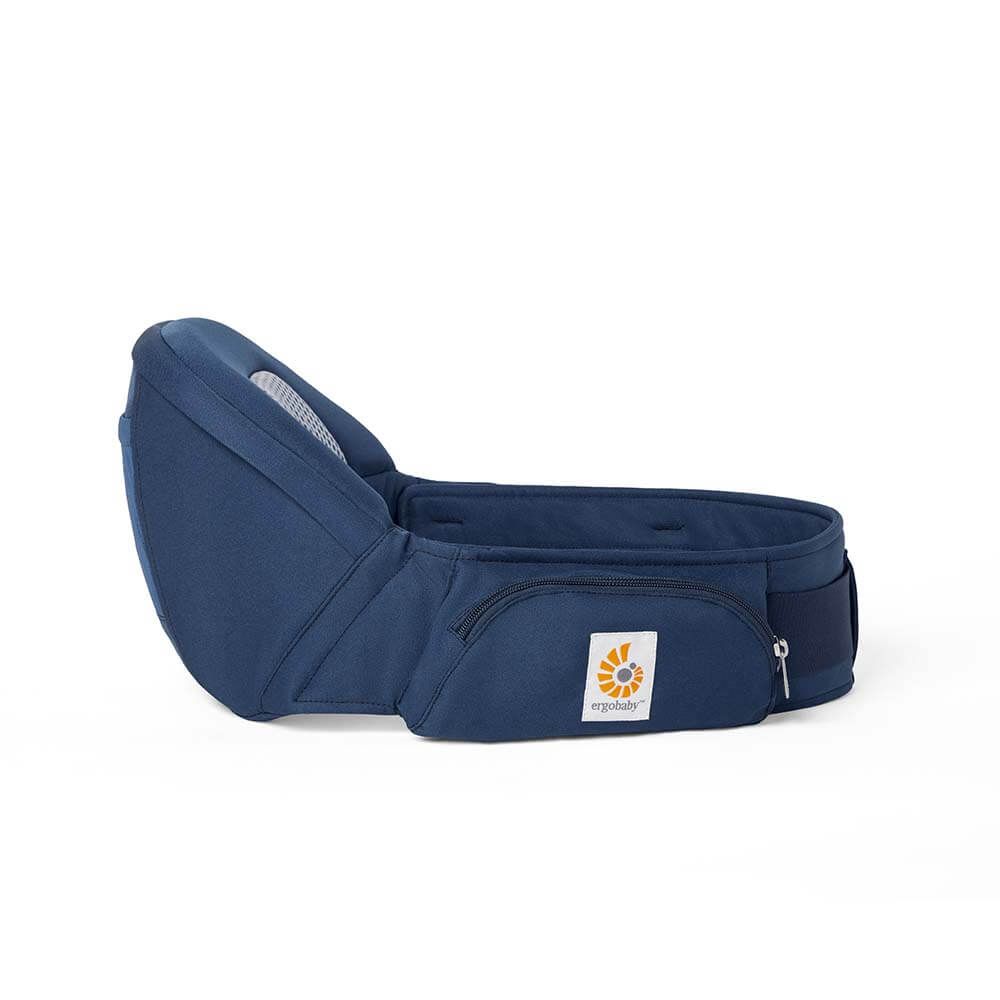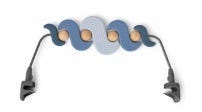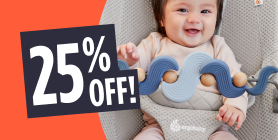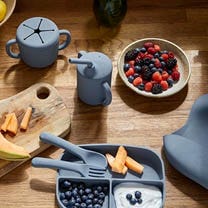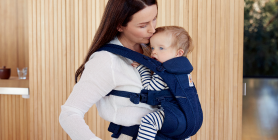Baby Gear
Babywearing
April 26, 2013
Urban Warrior Mama by ergobaby
Mamalicious Nursing Top / Old Navy plus size bootcut jeans / Keen Footwear lacing shoes / Laptop satchel / Vera Bradley eyewear / Ergobaby® Organic Baby Carrier
With spring springing up all around us I'm itching to take my kids out to explore the city. The cherry blossoms blooming, the fountains spouting water after a dormant winter, and the sunshine streaming down are beckoning to us after months of being mostly indoors.
In order to tackle our beloved concrete jungle here is what I'll need:
Ergobaby Carrier: Navigating busy streets, public transportation, and small cafes is no place for a stroller. Keeping baby close, safe, and out of trouble while still looking great is possible with a great carrier
Large Bag: I like something I can sling over my shoulder that will fit diaper changing supplies, a few snacks, a water bottle and my wallet.
Sunglasses: To keep the glare away and complete the look.
Teething Necklace:
Baby Gear
Babywearing
March 05, 2013
It seems that in many Western societies, one of the first things people do when they find out they’re expecting is to look at strollers, baby carriers, bassinets, anything that will hold your child for you. Yet, most people don’t realize that there is another way to keep your little ones with you, a way that is far superior in many regards and will also be much cheaper: babywearing. Historically, and in many other cultures today, strollers and other baby carrying gadgets are simply not used. Babies are wrapped and strapped to their caregiver to get around when their own two legs can’t take them. Though some might argue that there’s no difference, or that our modern inventions are more convenient, I would like to argue that there are actually good reasons to wear your baby. So here I present what I believe to be are five of the best reasons to wear your baby…
Reason #1: Babywearing allows for lots of touch
Sadly, infants and children are not receiving the amount of touch they
Baby Gear
Babywearing
February 25, 2013
From: Documenting Delight, Images for Ergobaby
Here at Ergobaby, we love it when our partners are also fans. So when we needed to create some images, we contacted Georgia at Documenting Delight. Not only is Georgia an acclaimed photographer, she's also a fan, so we were thrilled when she agreed to photograph some images for us. She has shared them in a recent post and not only are they beautiful, but joyful and funny (as evidenced by her hamming-it-up-husband above!). We think she's perfectly captured the spirit of Ergobaby: joyful, spirited, adventurous, loving and free.
Please head over to her site for a sneak peek of some of her gorgeous shots.
How would you describe the "Spirit of Ergobaby"?
Baby Gear
Babywearing
January 10, 2013
Ergobaby Zebra by ergobaby
Plein Sud Jeanius turtle neck sweater, $80 / Slim jeans / London Rebel ballerina pumps, $64 / TOMS red canvas shoes / TOMS black glitter flat, $62 / Aspinal of London , $520 / Zebra print handbag, $3.59 / Friis & Company cuff bracelet, $26 / Miso feather earrings, $5.61 / Kazuri stacking bangle, $48 / VILA , $26 / Lesley Evers / Aspinal of London / Original Ergo Baby Canvas Carrier Zebra by Ergobaby
Get styling with our newly launched Ergobaby Zebra Carrier. In honor of Kate Middleton's 31st Birthday yesterday, we put together this fun collection! Lets celebrate her from across the Atlantic in true British Fashion in style!
Baby Gear
Babywearing
November 09, 2012
Have you ever noticed that it’s rare to find picture books with images of babies at the breast or cradled in a carrier? Stop by any bookstore and you’re bound to notice the omission. Though there certainly isn’t anything wrong with cribs and bottles, I’d also love to see more imagery of babywearing, cosleeping, and breastfeeding in children’s books…to help normalize these wonderful practices for little ones.
Illustrator Marla Frazee has done a particularly outstanding job in this category. Take, for example, “Everywhere Babies” – a book that features all of the amazing things that babies do – including being carried by their parents all around town. Written by Susan Meyers, the rhyming text is sure to immediately captivate young ones (and parents too).
Another splendid story is “The Seven Silly Eaters” by Mary Ann Hoberman. Parents will sympathize with Mrs. Peters desperate plight to please her very picky eaters and kids will roar with laughter at the sheer absurdity
Baby Gear
Babywearing
October 04, 2012
In honor of the Design Ergobaby's Next Carrier contest, I thought I’d share my current fall fashion inspirations and some tips to purchase the right Ergo Carrier based on both your personal style and your babywearing needs.
This season the fashion runways and stores have seen a change in trends for fall and winter – no more streamlined and minimalist pieces! It’s all about shape, texture, pattern and color. The top trends I’m loving right now are:
Jewel Tones
The colors of teal, emerald, gold, colbalt, purple and burgundy look good on every skin tone and next to every hair color. I can’t wait to purchase a pair of skinny jeans or a pair of ballet flats in one of these beautiful colors.
Leather
I am a huge fan of a good looking faux leather jacket, specically one that is motorcycle inspired or has that worn in feel.
Bold Prints
Najavo, polka dots, stripes, geometric – I love them all! It’s nice to see basic pieces like a long sleeved sweater or a simple blouse with some pattern to them
Baby Gear
Babywearing
July 28, 2012
When we found out that my cousin would be getting married in Seattle in May 2012, we decided to take a few extra days off and make it into a fun family vacation. High in priority on our packing list for any trip is our Ergobaby Carrier. Back when we had a two year old and a new baby, we bought a second Ergo. Now that our children are older (5 ½ years, 3 ½ years, and 5 months old), we are only using the Ergo with our newest baby. Don’t get me wrong, having two Ergobaby Carriers still comes in quite handy! We are able to keep one in the car and one in the house at all times. But, traveling is an exception! There are too many variables when traveling with young children. You never know what will happen, so always take both of the Ergobaby Carriers!
As has been our experience, the Ergobaby Carrier made traveling by plane much simpler. No surprise there! Once we arrived in Seattle, we decided to buy a City Pass in order to see all of the best attractions at
Baby Gear
Babywearing
July 24, 2012
When our first baby was born we were given a hand-me-down Ergo and we nestled our precious newborn in it with the infant insert – and so began our love affair with babywearing.
Ever since then, there has always been an Ergo in our home. Our first baby is now an active two year old and Ergo has carried him (literally) through every stage – it could be easily be the only carrier you ever need. Of course if you are like us, you might want to try all kinds of different carriers – and even several types of Ergo carriers. There are several carriers we love, but Ergo has always been in heavy rotation in our home. Here are the top reasons we always keep our Ergo within arm’s reach:
Newborn Insert: We loved that we could use it as soon as we brought our baby home with the insert. It came in really handy when our snuggly and sleepy newborn wanted to always be close – but we needed our hands free for basic tasks.
Sleepy Magic: During those tricky times
Baby Gear
Babywearing
July 22, 2012
From: Jodi Kendall Blog "This carrier's comfort stood out during the testing process, and both my husband and I can vouch that we didn't ache or have sore spots after using it. One thing to note about the Aussie Khaki color: it's a new color option for the company, and I especially loved that it channeled a bit of the explorer in me with its look, and my husband felt like it had enough masculine edge for him to feel comfortable wearing too. This carrier color is a great option for couples who crave functional features and something neutral and attractive in appearance. If I was taking my son Townes on one of my expeditions, this is the carrier I would reach for!" Head over to Jodi's blog for the entire review and an exclusive discount code!Emotional Benefits of Getting Outside
Spending time in nature with your baby can strengthen the bond between you. The simple act of holding your baby close, feeling their warmth, and sharing new experiences together can create strong
Baby Gear
Babywearing
May 17, 2012
Back wearing, also known as Back Carrying, seems to elicit both interest and a little bit of fear from babywearing parents. While Back Carrying is one of the most liberating types of carries--it enables you to be hands-free and keep the baby safe from whatever you are doing--it seems to be one of the most daunting carries for parents. Carrying your baby on your back allows the parent to perform many tasks that would otherwise be difficult with a baby on the front. Of course, as with any carry, there are safety precautions, but when followed, the Back Carry can become an indispensable tool in the babywearer’s toolkit--grocery shopping, laundry, meal prep (put baby down when working with anything hot!), dishes, trips to the farmer’s market, for example--all become so much easier with the Back Carry! This is also an ideal carry for the baby to play or really observe the world around her. Historically, Back Carrying has been an essential part of life in many parts of





